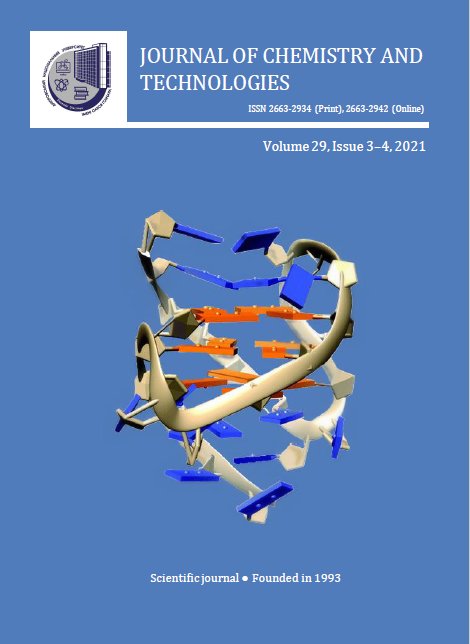USE OF NATURAL SORBENTS TO REDUCE NITRATE CONTENT IN NATURAL JUICES
DOI:
https://doi.org/10.15421/jchemtech.v29i4.235568Keywords:
vegetable juices; nitrate pollution; sorbent; thermodynamic parameters; sorption.Abstract
Today, the search for the most optimal modes of storage and processing of fresh plant products, which reduce the content of nitrates in food, remains relevant. In this work, the possibility of using natural sorbents of different nature to reduce the content of nitrates in fresh vegetable juices was studie. The juice was separated from the sorbent by filtration and the filtrate was analyzed for nitrate content by the ionometric method on a pH meter-ionometer "Expert-001". The sorption activity of sorbents was calculated according to the indicators of the total binding index (R, %) and distribution coefficient (D), sorption isotherms were constructed and their thermodynamic parameters were determined. The objects of the study were fresh vegetable juices; dispersed mineral bentonite, gelatin and synthetic flocculant polyoxyethylene were used as sorbents. Determination of the total binding index (R, %) and the sorbents’ distribution coefficient (D) of nitrates from juices showed that the use of sorbents reduces the nitrate content by an average of 1.2–1.9 times. The maximum sorption activity at 3 hours of contact with the juice occurred with bentonite (total nitrate binding 16.1%; distribution coefficient 19.0), the minimum – with the synthetic sorbent polyoxyethylene (total binding 5.5%; distribution coefficient 5.8). It is established that the experimental production of Langmuir adsorption isotherms and the calculation of thermodynamic properties of sorption allow tp optimize the choice of sorbents to reduce nitrate contamination of fresh vegetable juices. The most effective sorbents for reducing the content of nitrates in natural juices are bentonite and gelatin. The given conditions of processing natural juices by sorbents can be recommended for prevention of nitrate pollution of natural juices at their production.
References
Bekhradinassab Е., Sabbaghi S. (2014). Removal of nitrate from drinking water using nano SiO2–FeOOH–Fe core–shell. Desalination. 347(1), 1–9.
Katan, М. В. (2009). Nitrate in foods: harmful or healthy? The American Journal of Clinical Nutrition, 90(1), 11–12.
https://doi.org/10.3945/ajcn.2009.28014
Yusuf С.E., Verbruggen H., Verstraete W. (2016). Nitrate reducing. Concrete Research. 83, 19–30.
Kharitonov, M. M., Lazarіеva, O. M., Lemіshko, S. M. (2015). [Ekologіchna otsіnka varіabelnostі vmіstu nіtratіv u ovochevikh ta plodovo-yagіdnikh kulturakh u Dnіpropetrovskіy oblastі]. Vіsnyk Poltavskoі derzhavnoі agrarnoі akademіі, (3), 29–31 (in Ukrainian).
Andryushchenko, V. K. (2009). [Soderzhaniye nitratov v ovoshchakh]. Voprosy pitaniya, (5), 57-59 (in Russian).
Rezaei М., Fani A., Moini AL., Mirzajani М. (2014). Determining Nitrate and Nitrite Content in Beverages, Fruits, Vegetables, and Stews Marketed in Arak, Iran. International Scholarly Research Notices. 6(4), 285–288.
Sreekishnan T. R. (2018). Bioelectroremediation of perchlorate and nitrate contaminated water: A review. Bioresource Technology. 225(10),331–339.
Rezaei, М., Fani, A., Moini, AL., Mirzajani, М. (2014). Determining Nitrate and Nitrite Content in Beverages, Fruits, Vegetables, and Stews Marketed in Arak, Iran. International Scholarly Research Notices, 6(4), 285–288.
https://doi.org/10.1155/2014/439702
Colla, G., Kim, Hye-Ji, Kyriacou, M. (2018). Nitrate in fruits and vegetables. Scientia Horticulturae, 237, 221–238. http://dx. doi. org/:10.1016/j.scienta.2018.04.016
Kostiuchok, N.V., Bessarab, O.S. (2016). [Doslidzhennia problemy zabrudnennia kharchovykh produktiv nitratamy ta yikh pokhidnymy], Materialy V Mizhnarodnoi naukovo-tekhnichnoi konferentsii molodykh uchenykh ta studentiv. Aktualni zadachi suchasnykh tekhnolohii : Ternopil, 236–237. (in Ukrainian)
Ranasinghe, R., Marapana, R. (2018). Nitrate and nitrite content of vegetables. Journal of Pharmacognosy and Phytochemistry. Vol. 7, No 4. pp. 324-326.
Kostiuchenko, A.A. (2016). [Sotsialno-humanitarnyi aspekt zhyttia liudyny: suchasni vyklyky]. Vplyv nitrativ na orhanizm liudyny: zb. tez dop. vseukr. stud. nauk.-prakt. konf. m. Nizhyn, 29–31.
Cockburn, A., Brambila, G., Fernandez, M-L. (2013). Nitrite in feed: From Animal health to human health. Toxicology and Applied Pharmacology, 270(3), 209–217. http://dx.doi. org/: 10.1016/j.taap.2010.11.008
Lundberg, J. O., Weitzberg, E., Gladwin, M. T. (2008). The nitrate-nitrite-nitric oxide pathway in physiology and therapeutics. Nat. Rev. Drug Discovery, 7, 156–167. http://dx. doi. org/:10.1038/nrd2466
Rathod, K. S., Velmurugan, S., Ahluwalia, A. (2016). A “green” diet-based approach to cardiovascular health? Is inorganic nitrate the answer? Mol. Nutr. Food Res, 60, 185–202. http://dx. doi. org/:10.1002/mnfr.201500313
Sheyko, T.V., Melnik, L. M., Martsenyuk, O. S. (2011). [Doslіdzhennya kіnetyky adsorbtsіі pektynovikh rechovyn shungіtom іz soku stolovogo buryaka]. Kharchova promyslovіst, (10–11), 203-207 (in Ukrainian).
Sheyko, T.V., Melnik, L.M., Zhestereva, N.A., Machai, N.Yu. (2011). [Adsorbtsіyne ochishchennya soku stolovogo buryaka vіd nіtrat-іonіv]. Tematichnii zbіrnyk naukovykh prats “Obladnannya ta tekhnologii kharchovykh vyrobnytstv”, (27), 311–316 (in Ukrainian).
Іvanchenko, A. V., Karlash, V. І., Yelatontsev, D. O., Danelska A. S. (2018). [Zastosuvannya kyslotno-aktyvovanogo tseolіtu v tekhnologіi ochishchennya stіchnykh vod vіd nіtratіv]. Vіsnik Vіnnitskogo polіtekhnіchnogo іnstytutu, (5), 13–17 (in Ukrainian).
Іvanchenko, A. V., Ocheretyuk, O. R., Voloshyn, M. D. (2009). [Ochystka stіchnykh vod vіd neorganіchnykh fosfatіv sorbentamy]. Voprosy khimii i khimicheskoy tekhnologii, 4, 180–182 (in Ukrainian).
DSTU 4948:2008. (2009). [Frukty`, ovochi ta produkty` yix pereroblennya. Metody` vy`znachennya vmistu nitrativ]. K.: Derzhspozhy`vstandart. (in Ukrainian).
Downloads
Published
Issue
Section
License
Copyright (c) 2022 Днипровский национальный университет имени Олеся Гончара

This work is licensed under a Creative Commons Attribution 4.0 International License.
- Authors reserve the right of attribution for the submitted manuscript, while transferring to the Journal the right to publish the article under the Creative Commons Attribution License. This license allows free distribution of the published work under the condition of proper attribution of the original authors and the initial publication source (i.e. the Journal)
- Authors have the right to enter into separate agreements for additional non-exclusive distribution of the work in the form it was published in the Journal (such as publishing the article on the institutional website or as a part of a monograph), provided the original publication in this Journal is properly referenced
- The Journal allows and encourages online publication of the manuscripts (such as on personal web pages), even when such a manuscript is still under editorial consideration, since it allows for a productive scientific discussion and better citation dynamics (see The Effect of Open Access).


